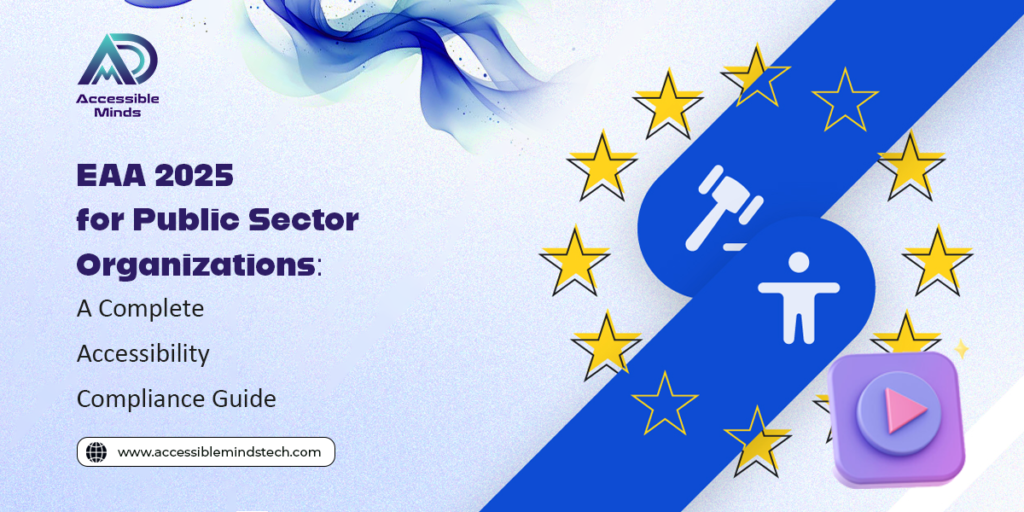In an era driven by digital transformation, accessibility is no longer a secondary consideration—it is a legal and ethical necessity. The European Accessibility Act (EAA) 2025 is a landmark directive that mandates accessibility standards for digital products and services across the European Union. For public sector organizations, the EAA represents both a compliance obligation and a powerful opportunity to build more inclusive digital ecosystems.
This guide will walk through what the EAA entails, who it affects, and how public sector institutions can prepare for compliance—particularly through Accessibility Testing Services, robust implementation planning, and continuous evaluation.
Understanding the EAA: Scope and Significance
The European Accessibility Act (EAA) will come into force across EU member states on 28 June 2025. Its primary aim is to standardise accessibility requirements for essential products and services within the EU’s internal market.
While the EAA applies to a wide range of sectors, public sector organizations—including government portals, educational institutions, health service providers, and municipal platforms—play a crucial role in implementing the standards. Their websites, mobile applications, e-services, and digital communication tools must meet harmonized accessibility benchmarks to ensure that people with disabilities have equal access to information and services.
What Needs to Be Accessible?
Under the EAA 2025, the following digital areas are particularly relevant to public sector organizations:
- Websites and mobile applications
- Self-service kiosks and terminals
- Public transport booking and information systems
- Digital documentation (PDFs, forms)
- Online banking and e-commerce services
- Digital communication channels (email, chatbots, etc.)
The technical standards referenced by the EAA closely align with the Web Content Accessibility Guidelines (WCAG) 2.1 Level AA, which detail how to make web content more accessible to people covering a range of disabilities such as visual, hearing, mobility, and cognitive challenges.
Why Accessibility Compliance Matters
1. Legal Obligation
Starting in 2025, failing to comply may lead to legal penalties, increased public scrutiny, and potential legal action. Member states are expected to enforce compliance through regular audits and reports. For the public sector, failure to comply undermines both the spirit and letter of inclusivity enshrined in EU law.
2. Social Responsibility
Public sector organizations exist to serve everyone, not just those without impairments. Digital accessibility ensures that vulnerable and disabled populations can engage with essential services, participate in governance, and access public information without barriers.
3. Operational Efficiency
Accessible platforms offer enhanced usability, are optimised for mobile devices, and demonstrate greater technical resilience. Investing in accessibility helps reduce user frustration, support tickets, and improves overall public trust in digital infrastructure.
Preparing for EAA 2025: Step-by-Step Compliance Guide
Step 1: Conduct a Digital Accessibility Audit
The first step to compliance is understanding where your digital assets currently stand. A thorough accessibility audit should cover:
- Websites and mobile apps
- PDF and document accessibility
- Interactive forms
- Third-party integrations
- Navigation structures and content readability
This is where Accessibility Testing Services become indispensable. Professional testing services use both automated tools and manual testing (including assistive technologies like screen readers) to evaluate real-world accessibility and provide actionable insights.
Step 2: Remediate and Optimise Content
Based on audit results, prioritize remediation. Fix issues such as:
- Missing alt text for images
- Poor colour contrast
- Inaccessible forms and navigation
- Lack of keyboard accessibility
- Inadequate focus indicators
Use WCAG 2.1 Level AA as your compliance benchmark and create a detailed roadmap for remediation. Update CMS templates, design systems, and UI components to reflect these improvements.
Step 3: Implement Accessibility in Development Life Cycle
Accessibility shouldn’t be retrofitted—it must be integrated from the start. Ensure your designers, developers, and content creators are trained in accessibility best practices. Adopt semantic HTML, ARIA roles, and ensure all dynamic content is accessible.
Additionally, ensure that your procurement processes include accessibility as a mandatory requirement when purchasing third-party platforms or software.
Step 4: Maintain an Accessibility Statement
The EAA requires public-facing accessibility statements that outline:
- The current compliance status
- Known accessibility issues
- Contact information for feedback
- A description of ongoing improvements
Keep this statement up to date to showcase ongoing improvements and encourage feedback from the public.
Step 5: Ongoing Monitoring and User Feedback
Compliance isn’t a one-off achievement. Continuously test your digital properties using internal audits, user testing with people with disabilities, and third-party Accessibility Testing Services. Set up feedback mechanisms so users can report accessibility issues directly.
Choosing the Right Accessibility Testing Partner
Choosing the right partner for testing and remediation is essential. Look for services that offer:
- WCAG and EAA-specific audits
- Manual and automated testing
- Assistive technology simulation
- Developer and content training
- Ongoing support and re-audits
Engaging a trusted provider not only ensures regulatory compliance but also embeds accessibility into your digital culture.
The Road Ahead
The EAA 2025 is not just a regulatory deadline—it’s a wake-up call for the public sector to lead by example. Ensuring digital accessibility is a matter of equity, dignity, and inclusiveness for all citizens. By embracing accessible design, leveraging professional Accessibility Testing Services, and fostering a culture of inclusion, public institutions can make the digital world a better, more equitable place for everyone.

